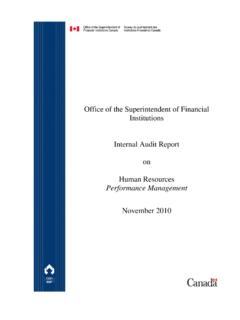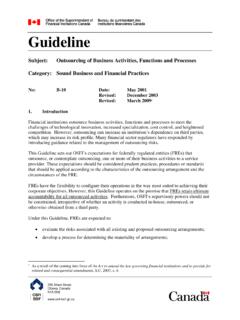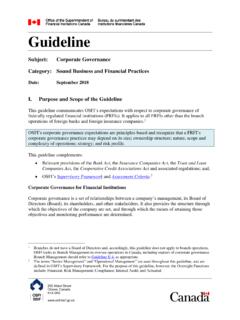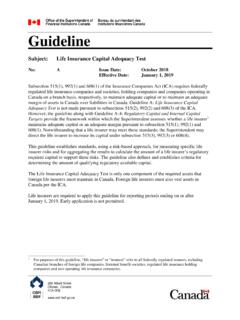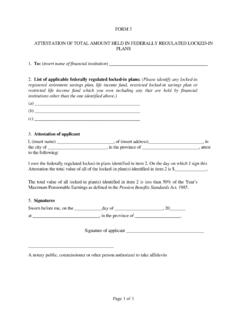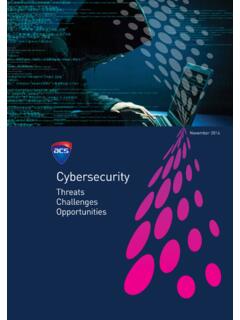Transcription of Guideline - Technology and Cyber Risk Management
1 Guideline Subject: Technology and Cyber Risk Management Category: Sound Business Practices and Prudential Limits No: B-13 Date: November 2021. A. Purpose and Scope This Guideline establishes OSFI's expectations related to Technology and Cyber risk Management and applies to all federally regulated financial institutions (FRFIs). These expectations aim to support FRFIs in developing greater resilience to Technology and Cyber risks. FRFIs should implement the expectations in this Guideline commensurate with its size; the nature, scope and complexity of its operations; and risk profile. OSFI's expectations are Technology -neutral, anticipating the need for FRFIs to compete effectively and take full advantage of digital innovation while maintaining a sound Technology posture. Definitions Technology risk refers to the risk arising from the inadequacy, disruption, failure, loss or malicious use of information Technology systems, infrastructure, people or processes that enable and support business needs and can result in financial loss.
2 Cyber risk or Cyber security risk is the risk of financial loss, operational disruption or reputational damage from the unauthorized access, malicious and non-malicious use, failure, disclosure, disruption, modification or destruction of an institution's information Technology systems and/or the data contained therein. A Technology asset is something tangible ( , hardware, infrastructure) or intangible ( , software, data, information) that needs protection and supports the provision of Technology services. For the purpose of this Guideline , Technology refers to information Technology (IT). The term Cyber also refers to information security. FRFIs may maintain their own definitions or employ definitions published by recognized standard-setting bodies. 255 Albert Street Ottawa, Canada K1A 0H2.
3 Structure This Guideline is organized into five domains. Each sets out key components of sound Technology and Cyber risk Management . 1. Governance and Risk Management Sets OSFI's expectations for the formal accountability, leadership, organizational structure and framework used to support risk Management and oversight of Technology and Cyber security. 2. Technology Operations Sets OSFI's expectations for Management and oversight of risks related to the design, implementation and Management of Technology assets and services. 3. Cyber Security Sets OSFI's expectations for Management and oversight of Cyber risk. 4. Third-Party Provider Technology and Cyber Risk Expanding on OSFI's existing guidance for outsourcing and third-party risk, sets expectations for FRFIs that engage with third-party providers to obtain Technology and Cyber services and/or other services that give rise to Cyber and/or Technology risk.
4 5. Technology Resilience Sets OSFI's expectations for capabilities to deliver Technology services through operational disruption. Domains for the sound Management of Technology and Cyber risk 1 2 3 4 5. Governance Technology Cyber Third-Party Technology and Risk Operations Security Provider Resilience Management Technology and Cyber Risk Greater resilience to Technology and Cyber risks 255 Albert Street Ottawa, Canada K1A 0H2. Outcomes The five domains in this Guideline each express a desired outcome for FRFIs to achieve through managing risk. In turn, these outcomes contribute to developing FRFIs' resilience to Technology and Cyber risks. Technology and Cyber risks are governed through clear accountabilities and structures, 1 and comprehensive strategies and frameworks. A Technology environment that is stable, scalable and resilient.
5 The environment is 2 kept current and supported by robust and sustainable Technology operating processes. A secure Technology posture that maintains the confidentiality, integrity and 3 availability of the FRFI's Technology assets. 4 Reliable and secure Technology and Cyber operations from third-party providers. 5 Technology services are delivered, as expected, through disruption. Related Guidance and Information Technology and Cyber security best practices are dynamic. Technology and Cyber risks also intersect with other risk areas. As such, FRFIs are advised to read this Guideline in conjunction with other OSFI guidance, tools and supervisory communications, as well as guidance issued by other authorities applicable to the FRFI's operating environment; in particular: OSFI Guideline E-21 (Operational Risk Management ).
6 OSFI Guideline B-10 (Outsourcing);. OSFI Cyber Security Self-Assessment Tool;. OSFI Technology and Cyber Security Incident Reporting Advisory;. Alerts, advisories and other communications issued by the Canadian Centre for Cyber Security; and, Recognized frameworks and standards for Technology operations and information security. 255 Albert Street Ottawa, Canada K1A 0H2. Table of Contents Page A. Purpose and Scope ..1..2..3. Guidance and Information ..3. 1. Technology and Cyber Governance and Risk Accountability and Organizational Technology and Cyber Technology and Cyber Risk Management Framework ..6. 2. Technology Operations ..7. Technology Architecture ..7. Technology Asset Management ..7. Technology Project Management ..8. System Development Life Cycle ..9. Change and Release Management .
7 10. Patch Management ..10. Incident and Problem Management ..11. Technology Service Measurement and Monitoring ..12. 3. Cyber Security ..12. Identify ..12. Defend ..14. Detect ..17. Respond, Recover and Learn ..18. 4. Third-Party Provider Technology and Cyber Risk ..19. General ..19. Cloud Computing ..20. 5. Technology Resilience ..20. Disaster Recovery ..21. Banks/FBBs/BHC/T&L/Co-ops/Life/P&C/IHC. Technology and Cyber Risk Management November 2021 Page 4 of 22. 1. Technology and Cyber Governance and Risk Management Outcome: Technology and Cyber risks are governed through clear accountabilities and structures, and comprehensive strategies and frameworks. Accountability and Organizational Structure Principle 1: Senior Management should assign responsibility for managing Technology and Cyber risks to senior officers.
8 It should also ensure an appropriate organizational structure and adequate resourcing are in place for managing Technology and Cyber risks across the FRFI. Senior Management accountability is established. Senior Management is accountable for directing the FRFI's Technology and Cyber security operations and should assign clear responsibility for Technology and Cyber risk governance to senior officers. Such roles may comprise: Head of Information Technology ; Chief Technology Officer (CTO); Chief Information Officer (CIO); Head of Cyber Security or Chief Information Security Officer (CISO). These roles should have appropriate stature and visibility throughout the institution. Appropriate structure, resources and training are provided. OSFI expects the FRFI to: Establish an organizational structure for managing Technology and Cyber risks across the institution, with clear roles and responsibilities, adequate people and financial resources, and appropriate subject-matter expertise and training.
9 Include among its Senior Management ranks persons with sufficient understanding of Technology and Cyber risks; and, Promote a culture of risk awareness in relation to Technology and Cyber risks throughout the institution. Please refer to OSFI's Corporate Governance Guideline for OSFI's expectations of FRFI. Boards of Directors in regard to business strategy, risk appetite and operational, business, risk and crisis Management policies. Technology and Cyber Strategy Principle 2: The FRFI should define, document, approve and implement a strategic Technology and Cyber plan(s). The plan(s) should align to the FRFI's business strategy and set goals and objectives that are measurable and evolve with changes in the FRFI's Technology and Cyber environment. Strategy is proactive, comprehensive and measurable.
10 The FRFI's strategic Technology and Cyber plan(s) should, at a minimum: Banks/FBBs/BHC/T&L/Co-ops/Life/P&C/IHC. Technology and Cyber Risk Management November 2021 Page 5 of 22. Anticipate and evolve with potential changes in the FRFI's internal and external Technology and Cyber environment;. Reference planned changes in the FRFI's Technology environment;. Clearly outline the drivers, opportunities, vulnerabilities, threats and measures to report on progress against strategic objectives;. Include risk indicators that are defined, measured, monitored and reported on;. Be accompanied by tools and processes that support enterprise-wide strategy implementation; and, Articulate the manner in which Technology and Cyber security operations will support the overall business strategy. Technology and Cyber Risk Management Framework Principle 3: The FRFI should establish a Technology and Cyber risk Management framework (RMF).

